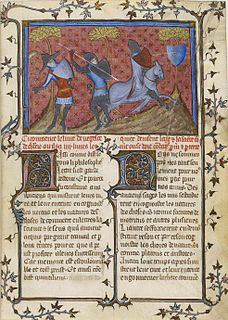
De re militari, also Epitoma rei militaris, is a treatise by the Late Latin writer Publius Flavius Vegetius Renatus about Roman warfare and military principles as a presentation of the methods and practices in use during the height of the Roman Empire and responsible for its power. The extant text dates to the 5th century.
Plumbatae or martiobarbuli were lead-weighted darts carried by infantrymen in Antiquity and the Middle Ages.

Gabriele Paleotti was an Italian cardinal and Archbishop of Bologna. He was a significant figure in, and source about, the later sessions of the Council of Trent, and much later a candidate for the papacy in 1590, and is now mostly remembered for his De sacris et profanis imaginibus (1582), setting out the Counter-Reformation church's views on the proper role and content of art.

János Zsámboky or János Zsámboki or János Sámboki, was a Hungarian humanist scholar: physician, philologist and historian.

Thomas Stapleton was an English Catholic priest and controversialist.
Roger de Piles's L'Abrégé de la vie des peintres...avec un traité du peintre parfait, was a major art biography of painters. It was written by the French spy Roger de Piles. In 1692, during the War of the League of Augsburg, he was arrested in the Hague carrying a false passport and imprisoned for the next five years, where he wote his L'Abrégé in 7 parts; 1) Sketch of the perfect painter, 2) Greek painters; 3) Painters from Rome & Florence; 4) Painters from Venice; 5) Painters from Lombardy; 6) Painters from Germany and the Low Countries; 7) Painters from France and ending with his famous "Balance of painters". The book was finally published in 1699 following his appointment as Conseiller Honoraire to the Académie de peinture et de sculpture in Paris.
Joachim Trognaesius, sometimes Trognesius or Trogney, was a printer and bookseller in late-16th-century and early-17th-century Antwerp.
Arnout Coninx (1548–1617) was a printer and bookseller in the city of Antwerp from 1579 until his death in 1617. In 1586 he was fined for unlicensed printing, and in 1591 he was investigated for selling forbidden books. When the city of Antwerp had been reconquered for Philip II of Spain in 1585, Protestants had been given four years to settle their affairs and leave or be reconciled to the Catholic Church. Coninx waited until 1590, after the deadline had passed, to register his conversion to Catholicism.
Lodewijk Makeblijde (1565–1630) was a Flemish Jesuit and a Renaissance poet and hymn writer.
Nicolas de Montmorency, count of Estaires, was an office holder and spiritual author in the Spanish Netherlands.

Maximiliaan de Vriendt, Latinized Maximus Æmilianus Vrientius (1559–1614), was a new Latin poet and a civic office-holder in the city of Ghent.
Jean Bogard was a printer in Leuven and Douai in the 16th and 17th centuries.
François-Hyacinthe Choquet was a Dominican hagiographer and spiritual author in the Spanish Netherlands.
Events in the year 1635 in the Spanish Netherlands and Prince-bishopric of Liège.
Balthazar de Moucheron was a Dutch trader, ship owner and one of the founders of the Dutch East India Company, but never participated as he went bankrupt in the same year. He is known for his early trading with India (Calcutta) and Indonesia, America, the west coast of Africa, the Baltic Sea and the White Sea (Archangelsk).

A military treatise or treatise on war is any work that deals with the "art of war" in some basic aspect. Fundamentally military treatises are treatises on military strategy. Other works may also be included in the definition that, although they deal with other topics, include sensitive information about military matters. These may include, among others, description of specific battles, sieges, general campaigns, reports of military authorities, and commented works about ground or naval battles.
Michel d'Esne de Betencourt (1540–1614) was a prelate in the Habsburg Netherlands.
Balthasar or Balthazar Bellerus or Bellère was a printer first at Antwerp and later at Douai in the Habsburg Netherlands. He was a son of the reputable Antwerp printer Joannes Bellerus, and set up a printing shop of his own in the Rue des Ecoles in Douai in 1590, becoming a colleague and rival to Jan Bogard. The motto that appeared on his printer's mark was Labore ac perseverantiâ. His marks were the golden compass and a unicorn dipping its horn in a stream.
Martinus Nutius or Martin Nuyts was the name of three successive printer-booksellers in 16th and 17th-century Antwerp. Collectively, they were active from 1540 to 1638.




